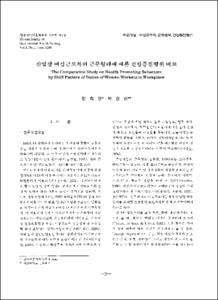산업장 여성 근로자의 근무형태에 따른 건강 증진 행위 비교
- Keimyung Author(s)
- Park, Kyung Min
- Department
- Dept. of Nursing (간호학)
- Journal Title
- 한국산업간호학회지
- Issued Date
- 1999
- Volume
- 8
- Issue
- 1
- Abstract
- This study intended to analyze the health promoting behaviors, compare their factors according to the shift pattern of duties of women workers who were working in the industrial workplace and present basic data in planning systematic and effective programs of health promotion for three-shift system and day-duty. Using Quota Sampling, 219 women workers were selected as subjects from 5 workshops which had 50 settled workers up to 300 and 10 factories which had more than 300 located in Taegu and Kyung-Book Province. Data were collected by means of questionnaire from September 12 to September 30, 1998. As the instruments of the study were used Health Promotion Lifestyle Profile(HPLP) which was adapted and adjusted by Seo, Y. O. for health promoting behavior, the one developed by Moon, J. S. (1990) for health-belief, the one developed by Sherer et al.(1982) and then adapted by Oh, H. S. for self-efficacy, and the one developed by Park, J. W. (1985) for social support. The analysis of data were performed with Cronbach's χ2-test, t-test, ANCOVA, Kendal tau, Pearson correlation, Stepwise Multiple Regression test using SPSS program. The results of the study are as follows : 1. There was a significant difference in age(χ2=32.46, p=0.000), career (χ2=18.47, p=0.000), working day(t=-3.18, p=0.000) by the shift pattern of duties in terms of socio-demographic characteristics. 2. There was a statistically significant difference between the two groups on the health promoting behaviors (t=2,52, p=0.012). The score of three-shift group on health promoting behaviors was 2.27, showing that it was lower by .13 than that of day-duty group(2.40). 3. ANCOVA involving age, career and working day as covariables, which had revealed significant difference before, showed that health promoting behaviors by the shift patterns of duties was significantly different(F=4.88, p=0.028). 4. In consideration of variables that have an influence on health promoting behavior by the shift pattern of duties, social support occupied 19.4% of health promoting behavior in the three-shift group and 22.5% including the sense of self-efficacy. In the day-duty group, social support occupied 34.4% of health promoting behavior. 5. The score of three-shift group(2.94) was significantly lower than that of day-duty group(3.12) in the perceived benefit of health-belief(t= -3.29, p=0.001), while the score of three-shift group (2.48) was significantly higher than that of day-duty group(2.24) in the perceived barrier (t=4.22, p=0.000). In the sense of self-efficacy(t=-4.20, p=0.000), the score of three-shift group(3.24) was significantly lower than that of day-duty group(3.53) while in social support(t=-4.56, p=0.000) the one of three-shift group(2.64) was significantly lower than that of day-duty group(2.88). The suggestions are as follows on the basis of the results of this study : 1. It is required to develop health promoting program that takes the shift pattern of duties of women workers into consideration. In addition, there are special demands on developing nursing strategies for health promoting behavior of three-shift workers. 2. It is required to develop specific strategies for social support which is the most significant factor to the health promoting behavior for women workers. 3. It is necessary to develop some programs for improving the sense of self-efficacy, social support, and health-belief of three-shift workers. To achieve these tasks, industrial nurses should play an active role and improve the ability of self-health care of women workers.
- Alternative Title
- The Comparative Study on Health Promoting Behaviors by Shift Pattern of Duties of Women Workers in workplace
- Keimyung Author(s)(Kor)
- 박경민
- Publisher
- College of Nursing
- Citation
- 장희정 and 박경민. (1999). 산업장 여성 근로자의 근무형태에 따른 건강 증진 행위 비교. 한국산업간호학회지, 8(1), 22–41.
- Type
- Article
- ISSN
- 1225-9586
- Appears in Collections:
- 2. College of Nursing (간호대학) > Dept. of Nursing (간호학)
- 파일 목록
-
-
Download
 oak-bbb-05182.pdf
기타 데이터 / 1.15 MB / Adobe PDF
oak-bbb-05182.pdf
기타 데이터 / 1.15 MB / Adobe PDF
-
Items in Repository are protected by copyright, with all rights reserved, unless otherwise indicated.